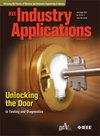Advanced Distribution Use of Network Pricing Method for Equitable Cost Allocation in Distributed Energy Resources Integrated Power Systems
IF 4.5
2区 工程技术
Q2 ENGINEERING, ELECTRICAL & ELECTRONIC
引用次数: 0
Abstract
Distribution Use of Network (DUoN) charges are crucial for recovering the costs of installing, operating, and maintaining the distribution network (DN) assets. This article presents a pricing algorithm to charge consumers and distributed energy resources (DERs) based on their impact on the distribution network. This method utilizes a sensitivity approach to calculate the deviation in system annual chargeable cost based on the incremental change in a) the real and reactive power flow of the facilities, b) the MW-Miles and MVAr-Miles flow of the system, and c) the power factor of the system. This reflects the combined effect of all these parameters and either charges or incentivizes the consumers based on the amount of real and reactive power they are consuming, the distance used to support customers’ real and reactive power injection/withdrawal, the capacity of DN assets being utilized while power is being delivered to consumers and influence on system power factor.The main advantage of the proposed approach is that it is not dependent on the tracing algorithm to detect the power flow paths, hence capable of computing DUoN for decent-sized DNs embedded with DERs, where the contribution of power to the consumers by the DERs or from the grid is difficult to determine or trace. Additionally, due to the appraising and penalizing characteristics of the proposed DUoN charging mechanism, the proposed pricing algorithm may encourage users to act based on local economic signals. This algorithm has been tested on a modified Western network, the IEEE-15 bus network, the IEEE-69 bus network, and the IEEE-123 bus network.分布式能源集成电力系统中基于网络定价方法的成本公平分配
分配网络使用(DUoN)费用对于回收分配网络(DN)资产的安装、操作和维护成本至关重要。本文提出了一种基于消费者和分布式能源对配电网影响的定价算法。该方法利用灵敏度方法,根据a)设施的实际功率流和无功功率流、b)系统的MW-Miles和MVAr-Miles流量以及c)系统的功率因数的增量变化来计算系统年收费成本的偏差。这反映了所有这些参数的综合影响,并根据消费者消耗的实功率和无功功率、用于支持客户实功率和无功功率注入/提取的距离、在向消费者供电时使用的DN资产容量以及对系统功率因数的影响对消费者进行收费或激励。所提出的方法的主要优点是它不依赖于跟踪算法来检测功率流路径,因此能够计算嵌入der的适当大小的dn的DUoN,其中der或电网对消费者的功率贡献难以确定或跟踪。此外,由于所提出的DUoN收费机制具有评价和惩罚的特点,所提出的定价算法可能会鼓励用户根据当地经济信号采取行动。该算法已在改进的Western网络、IEEE-15总线网络、IEEE-69总线网络和IEEE-123总线网络上进行了测试。
本文章由计算机程序翻译,如有差异,请以英文原文为准。
求助全文
约1分钟内获得全文
求助全文
来源期刊

IEEE Transactions on Industry Applications
工程技术-工程:电子与电气
CiteScore
9.90
自引率
9.10%
发文量
747
审稿时长
3.3 months
期刊介绍:
The scope of the IEEE Transactions on Industry Applications includes all scope items of the IEEE Industry Applications Society, that is, the advancement of the theory and practice of electrical and electronic engineering in the development, design, manufacture, and application of electrical systems, apparatus, devices, and controls to the processes and equipment of industry and commerce; the promotion of safe, reliable, and economic installations; industry leadership in energy conservation and environmental, health, and safety issues; the creation of voluntary engineering standards and recommended practices; and the professional development of its membership.
 求助内容:
求助内容: 应助结果提醒方式:
应助结果提醒方式:


